
在Vue.js中连接服务器的主要方法有1、使用Axios库、2、使用Fetch API、3、使用Vue Resource插件。这三种方法可以有效地帮助开发者与服务器进行通信,获取或发送数据。接下来,我们将详细介绍这三种方法及其应用场景。
一、使用Axios库
Axios是一个基于Promise的HTTP客户端,可以用于浏览器和Node.js。它是Vue.js项目中最常用的库之一,因其简单易用且功能强大。
1. 安装Axios
首先,您需要在Vue项目中安装Axios。使用以下命令进行安装:
npm install axios
2. 引入Axios
在Vue组件或全局文件中引入Axios:
import axios from 'axios';
3. 使用Axios发送请求
通过Axios发送GET、POST等请求:
// GET请求
axios.get('https://api.example.com/data')
.then(response => {
console.log(response.data);
})
.catch(error => {
console.error(error);
});
// POST请求
axios.post('https://api.example.com/data', {
key1: 'value1',
key2: 'value2'
})
.then(response => {
console.log(response.data);
})
.catch(error => {
console.error(error);
});
4. 在Vue组件中使用Axios
在Vue组件的生命周期方法中使用Axios:
export default {
data() {
return {
info: null
};
},
created() {
axios.get('https://api.example.com/data')
.then(response => {
this.info = response.data;
})
.catch(error => {
console.error(error);
});
}
};
二、使用Fetch API
Fetch API是现代浏览器中提供的原生方法,用于进行HTTP请求。它比传统的XMLHttpRequest更简洁,并且基于Promise。
1. 发送GET请求
使用Fetch API发送GET请求:
fetch('https://api.example.com/data')
.then(response => response.json())
.then(data => {
console.log(data);
})
.catch(error => {
console.error(error);
});
2. 发送POST请求
使用Fetch API发送POST请求:
fetch('https://api.example.com/data', {
method: 'POST',
headers: {
'Content-Type': 'application/json'
},
body: JSON.stringify({
key1: 'value1',
key2: 'value2'
})
})
.then(response => response.json())
.then(data => {
console.log(data);
})
.catch(error => {
console.error(error);
});
3. 在Vue组件中使用Fetch API
同样地,可以在Vue组件的生命周期方法中使用Fetch API:
export default {
data() {
return {
info: null
};
},
created() {
fetch('https://api.example.com/data')
.then(response => response.json())
.then(data => {
this.info = data;
})
.catch(error => {
console.error(error);
});
}
};
三、使用Vue Resource插件
Vue Resource是一个专门为Vue.js设计的HTTP客户端插件,尽管它的使用率逐渐被Axios取代,但仍然是一个有效的选择。
1. 安装Vue Resource
首先,安装Vue Resource:
npm install vue-resource
2. 引入Vue Resource并配置
在项目的入口文件中引入并使用Vue Resource:
import Vue from 'vue';
import VueResource from 'vue-resource';
Vue.use(VueResource);
3. 使用Vue Resource发送请求
通过Vue Resource发送GET、POST请求:
// GET请求
this.$http.get('https://api.example.com/data')
.then(response => {
console.log(response.body);
})
.catch(error => {
console.error(error);
});
// POST请求
this.$http.post('https://api.example.com/data', {
key1: 'value1',
key2: 'value2'
})
.then(response => {
console.log(response.body);
})
.catch(error => {
console.error(error);
});
4. 在Vue组件中使用Vue Resource
同样地,可以在Vue组件的生命周期方法中使用Vue Resource:
export default {
data() {
return {
info: null
};
},
created() {
this.$http.get('https://api.example.com/data')
.then(response => {
this.info = response.body;
})
.catch(error => {
console.error(error);
});
}
};
总结与建议
综上所述,Vue.js中连接服务器的主要方法有1、使用Axios库,2、使用Fetch API,3、使用Vue Resource插件。每种方法都有其优缺点:
- Axios:功能强大、易于使用、支持拦截器和取消请求,适合大多数项目。
- Fetch API:原生支持、基于Promise,但需要手动处理一些边界情况(如超时、取消请求等)。
- Vue Resource:与Vue.js集成良好,但社区支持逐渐减少。
根据项目需求选择合适的方法。如果您希望使用一个全面且社区支持广泛的解决方案,推荐使用Axios。如果您希望使用浏览器原生支持的方法,Fetch API也是一个不错的选择。Vue Resource适合那些已经在老项目中使用该插件的情况。
无论选择哪种方法,确保代码结构清晰,错误处理完备,以便于维护和扩展项目。在实际开发中,可以根据具体需求和项目特点灵活选择和切换这些方法。
相关问答FAQs:
1. Vue使用什么方法连接服务器?
Vue.js是一个用于构建用户界面的JavaScript框架,它本身并不提供直接连接服务器的方法。然而,Vue.js通常与其他后端技术(如Node.js)一起使用,以便实现与服务器的通信。
2. 如何在Vue中连接服务器?
在Vue中连接服务器可以通过以下几种方法来实现:
a. 使用Axios:Axios是一个基于Promise的HTTP客户端,可以在浏览器和Node.js中发送HTTP请求。通过使用Axios库,我们可以在Vue组件中轻松地发送GET、POST等请求到服务器。
例如,在Vue组件中安装Axios并发送GET请求:
// 安装Axios
npm install axios
// 在Vue组件中使用Axios
import axios from 'axios';
export default {
data() {
return {
serverData: null
};
},
mounted() {
axios.get('/api/data')
.then(response => {
this.serverData = response.data;
})
.catch(error => {
console.log(error);
});
}
}
b. 使用Fetch API:Fetch API是浏览器内置的现代化的JavaScript API,用于发送HTTP请求。它提供了一种更简洁的方式来发送请求,并且在某些方面比Axios更强大。
例如,在Vue组件中使用Fetch API发送GET请求:
export default {
data() {
return {
serverData: null
};
},
mounted() {
fetch('/api/data')
.then(response => response.json())
.then(data => {
this.serverData = data;
})
.catch(error => {
console.log(error);
});
}
}
c. 使用WebSocket:如果需要实时的双向通信,可以使用WebSocket来连接服务器。Vue.js并不直接提供WebSocket的功能,但可以使用第三方库(如Socket.io)来实现WebSocket的连接和通信。
3. Vue与服务器之间的连接有什么优势?
使用Vue与服务器连接可以带来以下几个优势:
a. 实时更新:通过与服务器连接,可以实现实时更新数据的功能。这对于需要实时展示数据变化的应用程序非常有用,例如聊天应用、股票行情等。
b. 异步通信:通过与服务器连接,可以异步地获取和发送数据。这样可以提高应用程序的性能和用户体验,避免阻塞用户界面。
c. 数据持久化:将数据存储在服务器上可以确保数据的持久性,即使用户关闭了应用程序或刷新了页面,数据也能够保存下来。
d. 安全性:通过与服务器连接,可以实现一些安全措施,例如身份验证和访问控制,以保护应用程序的数据和功能不受未经授权的访问。
文章标题:vue用什么方法连接服务器,发布者:不及物动词,转载请注明出处:https://worktile.com/kb/p/3574972

 微信扫一扫
微信扫一扫  支付宝扫一扫
支付宝扫一扫 